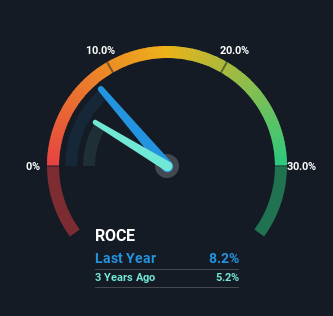Finding a business that has the potential to grow substantially is not easy, but it is possible if we look at a few key financial metrics. In a perfect world, we'd like to see a company investing more capital into its business and ideally the returns earned from that capital are also increasing. If you see this, it typically means it's a company with a great business model and plenty of profitable reinvestment opportunities. Having said that, from a first glance at RATH (VIE:RAT) we aren't jumping out of our chairs at how returns are trending, but let's have a deeper look.
Understanding Return On Capital Employed (ROCE)
For those who don't know, ROCE is a measure of a company's yearly pre-tax profit (its return), relative to the capital employed in the business. The formula for this calculation on RATH is:
Return on Capital Employed = Earnings Before Interest and Tax (EBIT) ÷ (Total Assets - Current Liabilities)
0.082 = €8.9m ÷ (€132m - €24m) (Based on the trailing twelve months to June 2023).
Therefore, RATH has an ROCE of 8.2%. On its own, that's a low figure but it's around the 9.9% average generated by the Basic Materials industry.
View our latest analysis for RATH

Historical performance is a great place to start when researching a stock so above you can see the gauge for RATH's ROCE against it's prior returns. If you're interested in investigating RATH's past further, check out this free graph covering RATH's past earnings, revenue and cash flow.
What Can We Tell From RATH's ROCE Trend?
The returns on capital haven't changed much for RATH in recent years. Over the past five years, ROCE has remained relatively flat at around 8.2% and the business has deployed 22% more capital into its operations. This poor ROCE doesn't inspire confidence right now, and with the increase in capital employed, it's evident that the business isn't deploying the funds into high return investments.
The Bottom Line
In conclusion, RATH has been investing more capital into the business, but returns on that capital haven't increased. Unsurprisingly, the stock has only gained 26% over the last five years, which potentially indicates that investors are accounting for this going forward. Therefore, if you're looking for a multi-bagger, we'd propose looking at other options.
RATH does come with some risks though, we found 5 warning signs in our investment analysis, and 2 of those are significant...
For those who like to invest in solid companies, check out this free list of companies with solid balance sheets and high returns on equity.
New: AI Stock Screener & Alerts
Our new AI Stock Screener scans the market every day to uncover opportunities.
• Dividend Powerhouses (3%+ Yield)
• Undervalued Small Caps with Insider Buying
• High growth Tech and AI Companies
Or build your own from over 50 metrics.
Have feedback on this article? Concerned about the content? Get in touch with us directly. Alternatively, email editorial-team (at) simplywallst.com.
This article by Simply Wall St is general in nature. We provide commentary based on historical data and analyst forecasts only using an unbiased methodology and our articles are not intended to be financial advice. It does not constitute a recommendation to buy or sell any stock, and does not take account of your objectives, or your financial situation. We aim to bring you long-term focused analysis driven by fundamental data. Note that our analysis may not factor in the latest price-sensitive company announcements or qualitative material. Simply Wall St has no position in any stocks mentioned.
About WBAG:RAT
RATH
Engages in the production and sale of refractory materials in Europe, Africa, the Middle East, the Americas, and the Asia Pacific.
Slight risk and slightly overvalued.
Market Insights
Community Narratives



